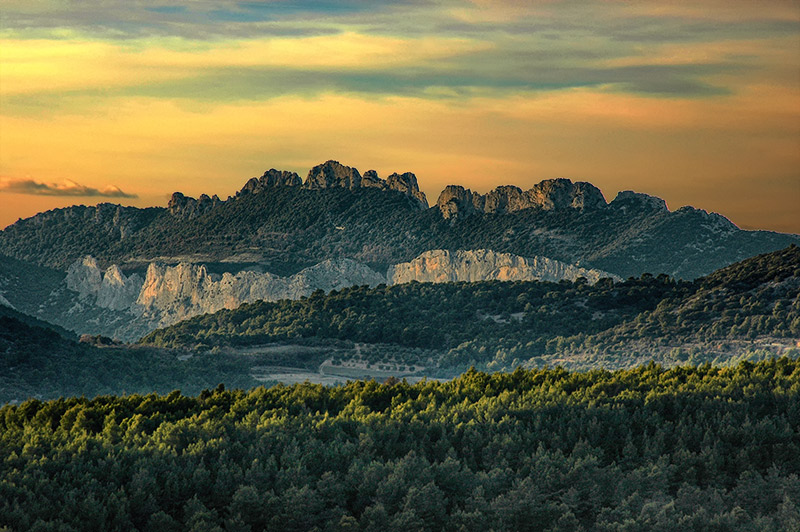Les dentelles de Montmirail,Photos Galleries
Cliquez sur la photos pour voir la Galerie Photos des Dentelles

Voir la Galerie Photos, Voir la vidéo
Voir Toutes Les GaleriesLe Vaucluse,Les Sites Naturels
Population 158 habitants, altitude: Min. 10 m — Max. 122 m
Nearby villages:
Beaumes-de-Venise - Crestet - Gigondas - La Roque-Alric - Lafare - Le Barroux - Malaucène - Sablet - Séguret - Suzette - Vacqueyras - Vaison-la-Romaine
The Dentelles, are a mountain range that marks the western boundary of the Vaucluse mountains
it is a paradise for outdoor activities: rock climbing, hiking, biking, have a bowl of pure and Nature in Provence.
North of Carpentras, south of Vaison-la-Romaine and west of Mount Ventoux is a triangular mountain range bounded
by the crest of Saint-Amand highest point at 732 meters to the north west by the plain of the Ouvèze, the south by that of Venaissin County to the east, with the parade leading from Barroux Malaucène, fault separation from the foothills of Mont Ventoux.
The massif, which is about eight kilometers long, is world renowned for its climbing walls. Located in the heart of the appellation Côtes du Rhône, he has built a reputation for the quality of its wines and for the production of its olive oil, protected by an AOC and for the quality of its truffles.
History:
The site was occupied by Celtic villages controlling the routes between the Rhone valley and Ventoux. In Vaison-la-Romaine, major archaeological discoveries have been made there (Celtic sword Celtic-Greek inscription, Gallo-Roman statuary), lace also sheltered two early Christian places of worship dating from the seventh century to the fourteenth century with the papal presence Avignon, grew the muscadières that provided the cellars of the Popes in muscat wine.
Laces positioned along the Rhone valley are exposed to erosion they are made of very thick limestone benches and faulted limestone slabs erected vertically .
terrace farming is an agricultural practice that began in the days when man began to control nature for cultivation. between economic and hydrological requirements
of rugged terrain. The difficulty of often scarce and poor soil is to tame both the sun and water. "
Called terraces in Provence, these culture terraces can rid the soil of stones which prevent planting. recover these stones are used to build stone walls
dry. soil level, have created bands of topsoil. during heavy rains, this technique can reduce or even avoid runoff gully that cultivated land.
In the massive, ancient terraced hillsides structure and sculpt the landscape. small and narrow, they follow and hug the slopes.
they are the result of the work of restanqueurs or Wallers, these laborers who could raise the walls. Until the early twentieth century, work the land by hand or with the horse,
was compatible with the cramped terraces and their very narrow or difficult access showed no major drawback.
Over time, many have been abandoned and overgrown with bushes.
From World War cereals, olive trees, fruit trees and vineyards descended on the plain.
The vines on the hillsides iinstallèrent:
In the massif, the heritage of ancient terraces was taken into account During the passage of AOC vines and has recolonized the terraces. On the slopes of the narrow benches,
have been adapted to the requirements of mechanization and modern techniques of viticulture while respecting the traditional spirit of their construction.
The quality of the wines produced can "think that the terraces will not disappear and that 'they still have good times ahead. "
From 1960 the vines become the main crop of the vineyard lace takes the place of the olive trees but also other crops such as cherry and apricot orchards
Currently 90% of farms that are wine and 81% who have their land classified as AOC.
The vineyard produces several names: Beaumes de Venice (AOC), Muscat de Beaumes-de-Venise (VDN), Gigondas (AOC), Vacqueyras (AOC) and the Côtes du Rhône Villages Séguret and Sablet. To improve the quality of their wines, in recent decades, growers increasingly abandoning the plain to install their vines on slopes and hillsides, which meant that
whole swathes of barren hills were cleared and turned into vineyards .
The olive groves were again on the rise since obtaining the AOC for their oil.
Olive oil from Provence was protected by a controlled designation of origin 14 March 2007.
Nearby village :
Beaumes-de-Venise - Crestet - Gigondas - La Roque-Alric - Lafare - Le Barroux - Malaucène - Sablet - Séguret - Suzette - Vacqueyras - Vaison-la-Romaine
